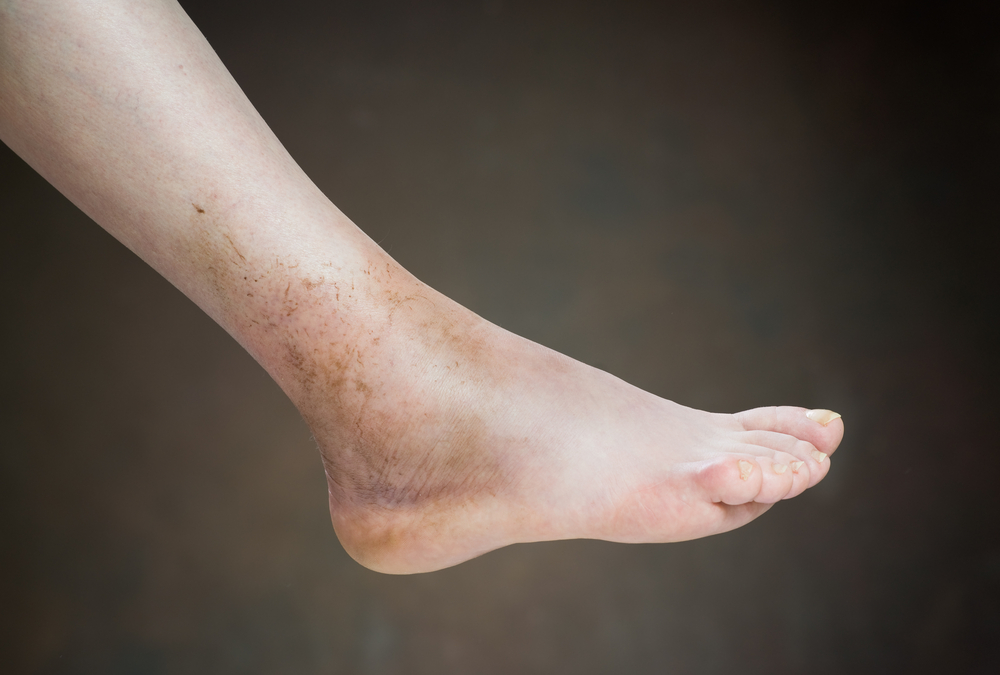Each of our feet is made up of 26 bones, 30 joints, and over 100 muscles, tendons, and ligaments. With so many structures interacting when you walk, run, or jump, it’s no wonder that the feet sometimes get injured, particularly when you participate in sports. While a sprained ankle isn’t usually serious and can heal on its own, seeing your local Prince George, Terrace, or Williams Lake foot doctor is a good idea if you have severe symptoms.
When you first get injured, you can try the RICE method for 4-6 weeks, but if you don’t get better, you’ll have to go to the clinic to get your symptoms evaluated. You should also come in if you have severe pain or problems bearing weight, or if the bruising and swelling is significant. Your doctor might be able to reassure you that everything is fine, and if not, they might give you a boot or even perform surgery to get your foot back to normal.
How Serious Is my Ankle Sprain?
Millions of people sprain their ankle every year, and most of them won’t develop long-term problems. They simply have to rest their foot for a few weeks and then ease back into exercise slowly, for example by going for walks before starting to run and by slowly increasing the distance they travel on foot. However, you might be facing a more severe issue if your symptoms don’t start to disappear despite the fact that you’ve been resting for weeks.
If you are still experiencing severe swelling and bruising as well as persistent pain when you try to bear weight on your foot weeks after your injury, it might be time to see a specialist. You could be suffering from a serious sprain that won’t heal on its own and could cause you long-term trouble.
The Three Classification Levels
Professionals distinguish between three different levels of sprains. People with a Grade 1 sprain might feel sore for a few days and experience slight swelling. The ligament is only overstretched, not torn, so such injuries heal quickly and often don’t need medical attention. A Grade 2 sprain involves a partial tear in the ligament, so it will take the patient longer to recover, and there might be some bruising. Medical attention is sometimes necessary.
A Grade 3 sprain is present when the ligament has snapped completely. You can often hear a popping sound when this injury happens. You will suffer from severe symptoms, and it might take you several months until you’re back to normal, so medical attention is crucial. Patients with a Grade 3 sprain will be unable to bear weight on the joint for some time because the ligament is no longer supporting the foot.
Severe Swelling, Bruising, and Pain
Almost everyone experiences some level of swelling or bruising when they sprain their ankle, but it isn’t very severe in most cases, and it should start to disappear after a while. If you suspect that your ligament has snapped and you have a Grade 3 ankle sprain, you should contact a medical professional immediately. Continuing to use the joint is almost impossible and would cause considerable damage.
Persistent Symptoms
Even if your ligament is only torn and not severed, you might notice that it takes a long time to heal. Both ligaments and tendons have less blood supply than other tissues such as muscles, so they often take much longer to recover from injury. Not being able to use your foot for many months can be a challenge, but your doctor can offer support, for example by providing you with a boot that allows you to put some weight on your foot.
What Should I Do?
You should speak to a foot doctor at your local Prince George, Terrace, or Williams Lake clinic if you believe that you have a very severe ankle sprain. They will be able to perform a physical examination and, if necessary, ask for an X-ray, MRI, or other imaging study to confirm their diagnosis. Then, they can prescribe medications against the pain, give you information about how to speed up your recovery, and tell you about other types of treatments.
If your sprain is very severe, your doctor might recommend surgery and physiotherapy to ensure that you can make a full recovery. They will also speak to you about what led to the injury and how you can prevent it from happening in the future. Some patients are more prone to sprains because of bad posture or walking habits, and these can be addressed at your clinic.
RICE
Most sprains can be treated with the RICE method, which includes rest, ice, compression, and elevation. Grade 1 sprains might heal within 1-3 weeks, so you won’t have to rest for lengthy periods of time. However, Grade 2 sprains will take longer, so a 4-6-week break from weight bearing exercise is recommended. During this time, you should elevate your foot as often as possible and ice it in a 10 minutes on, 20 minutes off cycle several times a day.
You can also compress your injury by wrapping an Ace bandage around it, but take care not to make the compression too tight. All of these measures can help to reduce your symptoms and increase blood flow to the area in order to speed up healing. Once your foot feels better, get back into exercise slowly to avoid a relapse. Start with short and low-impact movements and gradually increase both the time and the impact of your exercise routine.
Wear a Boot
Patients who have trouble walking because of their sprain will often be advised to wear a brace, boot, or cast to prevent further injuries and allow them to remain mobile. Your ankle won’t be able to move within the boot, so it has time to rest. You also won’t feel as much pain because you’ll be prevented from placing undue pressure on your joint. Most people wear their boot for around two to six weeks, but your doctor can tell you when you’re ready to take it off.
Have Surgery
Sometimes, lateral ankle ligament reconstruction is necessary to tighten up the ligaments on the outside of your ankle. Fortunately, this is rare, and even Grade 3 sprains usually heal on their own if given enough time. However, patients with repeated sprains or those who also have other conditions such as high arches, hindfoot varus, or Ehlers-Danlos might have loose ligaments that make their foot unstable, so surgery is recommended to prevent reinjury.

